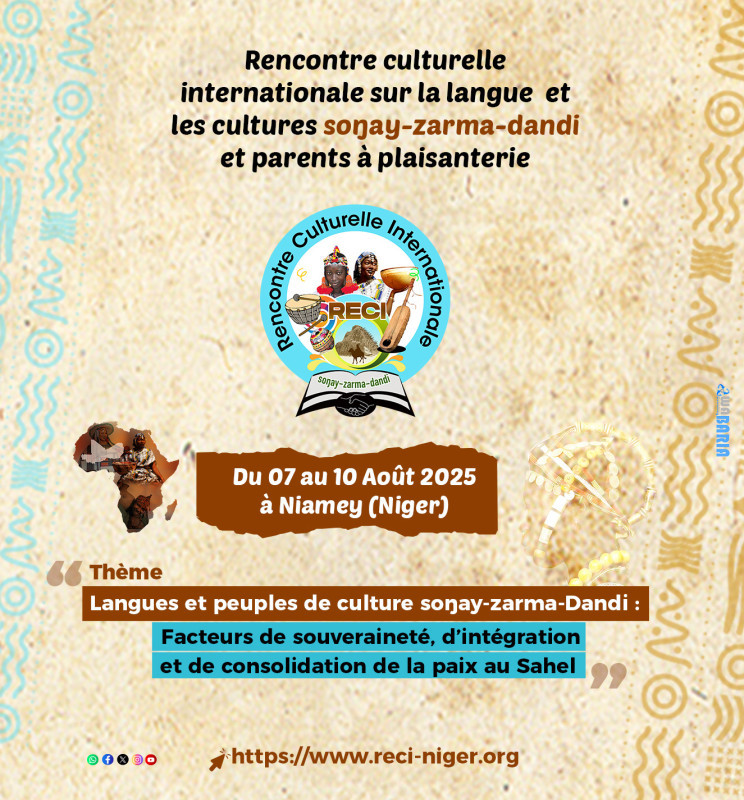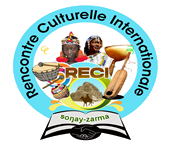Colloque scientifique international

International Symposium on Language, Culture, History, Values and other Riches of the Soŋay -Zarma- Dendi
Niamey, from 07 to August 11 2025
International Scientific Symposium
Topic : « Language, People and Soŋay -Zarma- Dendi’s Culture : Integration and Consolidation of Peace in the Sahel »
CALL FOR PAPERS
|
Soumission |
Dates |
Déroulement |
|
Send your paper in word version to : colloqueayneha2025@gmail.com |
- Submission deadline: March 25, 2025 - Paper’s notification of acceptance: March 28,2025 |
In hybrid format (face-to-face and videoconferencing) from August 07 to 11, 2025 |
Introduction
As part of the valuation of the Soŋay language and culture, an international cultural meeting was organized in Ouagadougou- Burkina Faso from March 25 to 30, 2019 which recommended the organization of an edition in Niamey in order to perpetuate the initiative. It is in this context that international cultural symposium is scheduled to be held in Niamey in August 2025.
The scientific component of this symposium relates to the organization of an international scientific conference on the theme « Language, people and culture Soŋay – Zarma – Dendi integration and consolidation of peace in the Sahel ». This conference is to be held from August 07 to 11, 2025 in Niamey- Niger. It is the continuation of series of symposium organized recently in Burkina Faso, Mali (March 2006 and March 2007) and in Niger (December 2009).
The axes of the scientific event tackle all aspects of the communities’ life: language, culture, education, history and settlement, security, literature, art, economy and development, climate change, water resources, etc.
The scientific committee set up for this purpose invites researchers, academics, civil society, writers, traditionalists and all other qualified people to respond to the present call for communication.
I. CONTEXT AND JUSTIFICATION
The Sonay language, which has different names through its geographical frame, is one of the cross-border languages of West Africa: Sonay in Mali, Sonay-Zarma-Dendi in Niger, Dendi in Benin, Sonay and Marense in Burkina Faso, among others. We find the speakers of these different varieties in other countries such as Nigeria, Ghana, Sudan, the Algerian South-West, without counting, with recent migrations, a strong diaspora living in different other regions of the world.
The history of the speaking communities of this language is closely related to that of the Sonay Empire, withthree main dynasties, in this case that of the Zaa (Dia), that of Soni (Si) and that of Askia. The long historyof this precolonial state testifies relations between the Sonay peoples and their neighbors, Tuareg, Bozo, Dogon, Peulh, Mossi, Gurmantche, Gurusi, Hausa, etc. from this coexistence were born relationships of different types such as joking cousinhood, weddings and many varieties of alliances which bear witness to a climate of peaceful coexistence and the emergence of a rich and inestricable ethnolinguistic and cultural brewing representing a factor of unificationin this largeSahel space, even in the African continent in general.
The living environment of these very wide communities covers a good part of the current states of Burkina Faso, Mali, Niger and Benin. These states have the common ambition which is the combination of their efforts with a view to the regulations of the multiple challenges they face.
Among these challenges we can cite poverty ,illicit traffic, cross-boder insecurity, the closure of many schools, important movementsof internal refuges and other factors of cyclical and structual vulnerability such as sub-production, paperization, environmental degradation, the exodus of youngesters and floods that have become recurring for more than a decade. This situation is mainly observed in the so-called three borders area.
In contrast from these factors of vulnerability, it is important to remind people that this vast entity is full of Natural ressources which are desired by multiple and multiforme actors. Added to these desires, the multiple challenges enumerated above then influence the local geopolitic.
These challenges weigh heavily on the future of the concerned space. There areresearchers and other holders of knowledge of all areas, relevant and innovatrice reflections likely to contribute to a rapid return to peace, social tranquility and the improvement of the economic conditions of the communities which have shared, for ages, this space and common values.
It is therefore important to envisage reflections around different dynamics in close relation to the Sonay-Zarma-Dendi language and culture. For example, the language used in the various media also acts as a languageof schooling, hence theimperative to take stock of almost half a century of teaching-learning associated with this language in the different concerned country.
At the economique level, the communities that live in the considered space,continue to depend on random rural productions(agriculture, breeding, picking, fishing, etc. However, this space is full of multiple strategic resources (gold, phosphate, iron, uranium, cobalt, lithium, water, etc.).Students must makeit possible to better contribute to the integrated and sustainable development programs, capable ofstrhgthening peace and creating better living conditions.
Thus a better appreciation of theserelationships through history, and in situ, it will make it possible to better understand the sources of current problems and to think of answers to stop and prvent the types of conflicts and other difficulties over major time who have deeply weakened these communities in recent years.
II. SYMPOSIUM OBJECTIVES
2.1. General objective
The aim of the symposium is to produce knowledge likely to contribute to the enhancement of the cultural, artistic, technical, social, political and economic potential of the soŋay-zarma-dendi area.
2.2 Specific objectives
The specific objectives are to contribute to :
- a better knowledge of the language, culture and educational systems in the soŋay-zarma-dendi area ;
- a better understanding of the soŋay-zarma-dendi communities through their history, settlement and interrelations with other communities;
- a better understanding of the main current and future social, geopolitical, environmental, economic and security issues and challenges ;
- a better understanding of the main factors and sources of vulnerability (of all kinds and types) of communities and their living environments;
- the identification of the most appropriate ways and means for a rapid return to peace and lasting peaceful coexistence.
III. COLLOQUIUM THEMES
Papers will focus on one of the following themes, within the framework of the geographical space of the soŋay-zarma-dendi communities. All proposals will be examined by the symposium's Scientific Committee.
Axis 1 : Language, culture, education
Papers in this area should cover the following issues :
- description of the soŋay language ;
- language and the education system ;
- language-culture relations, social norms ;
- language digitization and instrumentation ;
- language and culture valorization, content production and dissemination ;
- health, education and cultural survival.
Axis 2 : History, territory and settlement
Papers in this axis should address the following issues :
- history, migration and settlement ;
- living environment and interrelations between peoples in the soŋay-zarma-dendi area ;
- typology and origins of joking cousins ;
- places of memory, territories, sites and historical personalities in the soŋay-zarma-dendi area.
Axis 3 : Economy and development
Papers in this axis should cover the following issues :
- population, growth and development issues ;
- natural resources and covetousness ;
- environment and climate change ;
- water as a geopolitical and economic issue.
Axis 4 : Land tenure, rural production systems and food sovereignty
Papers in this axis should address the following issues :
- land and shared spaces;
- agricultural, food and nutritional issues ;
- livestock and pastoral practices ;
- fishing, fish farming and preservation of fishery resources;
- gathering products and economic issues.
Axis 5 : Governance, peace and security challenges
Papers in this axis should address the following issues :
- geopolitics and security issues ;
- local governance (political, administrative, community and customary) ;
- lifestyles and peaceful coexistence of communities.
IV. EXPECTED RESULTS
Expected results include:
- the language, culture and educational systems in the soŋay-zarma-dendi area are well valued and proposals formulated for taking them into account in schooling;
- the history of settlement and interrelations with other communities are better known;
- the main current and future social, geopolitical, environmental, economic and security issues and challenges are better understood;
- the main factors and sources of vulnerability of communities and their living environments are well identified;
- the most appropriate ways and means for a rapid return to peace and lasting peaceful coexistence are identified.
V. METHODOLOGY
With a view to an overall assessment of the work carried out on the theme “Language, people and soŋay-zarma-dendi culture : integration and peace-building in the Sahel”, inaugural conferences will first be presented for each of the above-mentioned axes. There will also be a specific paper reviewing the cultural Soŋay encounters organized in Mali, Burkina Faso, Niger, Benin, Sudan, France, Ghana, etc.
Other papers will be presented by axis, in panels, followed by discussions.
Papers will be presented face-to-face and by videoconference.
In addition to the panels dedicated to papers, other discussion forums are planned between (1) traditional chiefs, (2) networks and associations of researchers and writers, (3) women, (4) young people, communicators, etc...
For each network or association to be set up, an organizer and a focal point per participating country will be identified, in liaison with the symposium organizers.
VI. SUBMISSION PROCEDURES, SUBMISSION TIMETABLE AND ADDRESS FOR RECEIPT OF ABSTRACTS
6.1. How to submit a proposal
Proposals must be concise, original and in line with scientific standards. The author must explicitly state the problem, the object of study, the nature of the data used, the methodological approach adopted and the bibliographical references.
Abstracts must also be accompanied by a short presentation of the author, not exceeding ¼ page. Abstracts must comply with the following criteria:
- title of paper: Times New Roman 12, normal ;
- first and last name of author(s) : Times New Roman 12, normal ;
- affiliation : Times New Roman 12, normal ;
- author(s) email and phone number : Times New Roman 12, normal ;
- summary of communication : 300 words maximum, Times New Roman 12, normal ;
- keywords : five maximum, Times New Roman 11, normal (please ensure that keywords are consistent with the title and proposed abstract).
Abstracts should be sent to the email address below :
Languages of communication : French, English, soŋay, Arabic.
6.2. Provisional timetable
- Call launch date : January 20, 2025 ;
- Deadline for receipt of abstracts : March 25, 2025 ;
- Deadline for notification of acceptance: March 28, 2025 ;
- Deadline for receipt of drafts of papers submitted for evaluation with a view to.
VII. PERSPECTIVES
Following the presentations, the best scientific contributions will be selected. The selected papers will be submitted to the Scientific Committee for publication (Conference Proceedings) before the end of 2025.

 English
English
 العربية
العربية
 Français
Français